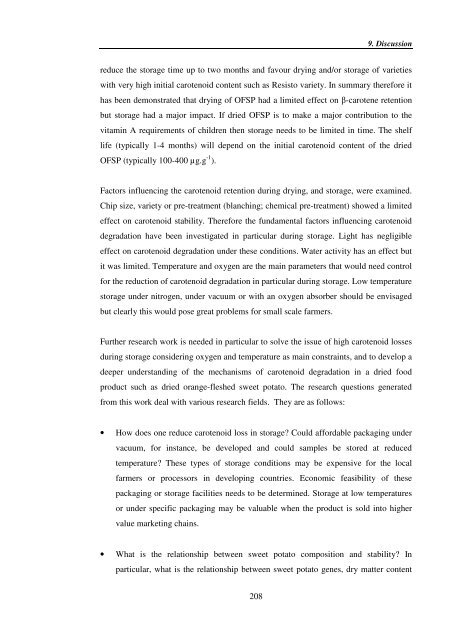Investigating carotenoid loss after drying and storage of
Investigating carotenoid loss after drying and storage of
Investigating carotenoid loss after drying and storage of
Create successful ePaper yourself
Turn your PDF publications into a flip-book with our unique Google optimized e-Paper software.
208<br />
9. Discussion<br />
reduce the <strong>storage</strong> time up to two months <strong>and</strong> favour <strong>drying</strong> <strong>and</strong>/or <strong>storage</strong> <strong>of</strong> varieties<br />
with very high initial <strong>carotenoid</strong> content such as Resisto variety. In summary therefore it<br />
has been demonstrated that <strong>drying</strong> <strong>of</strong> OFSP had a limited effect on !-carotene retention<br />
but <strong>storage</strong> had a major impact. If dried OFSP is to make a major contribution to the<br />
vitamin A requirements <strong>of</strong> children then <strong>storage</strong> needs to be limited in time. The shelf<br />
life (typically 1-4 months) will depend on the initial <strong>carotenoid</strong> content <strong>of</strong> the dried<br />
OFSP (typically 100-400 µg.g -1 ).<br />
Factors influencing the <strong>carotenoid</strong> retention during <strong>drying</strong>, <strong>and</strong> <strong>storage</strong>, were examined.<br />
Chip size, variety or pre-treatment (blanching; chemical pre-treatment) showed a limited<br />
effect on <strong>carotenoid</strong> stability. Therefore the fundamental factors influencing <strong>carotenoid</strong><br />
degradation have been investigated in particular during <strong>storage</strong>. Light has negligible<br />
effect on <strong>carotenoid</strong> degradation under these conditions. Water activity has an effect but<br />
it was limited. Temperature <strong>and</strong> oxygen are the main parameters that would need control<br />
for the reduction <strong>of</strong> <strong>carotenoid</strong> degradation in particular during <strong>storage</strong>. Low temperature<br />
<strong>storage</strong> under nitrogen, under vacuum or with an oxygen absorber should be envisaged<br />
but clearly this would pose great problems for small scale farmers.<br />
Further research work is needed in particular to solve the issue <strong>of</strong> high <strong>carotenoid</strong> <strong>loss</strong>es<br />
during <strong>storage</strong> considering oxygen <strong>and</strong> temperature as main constraints, <strong>and</strong> to develop a<br />
deeper underst<strong>and</strong>ing <strong>of</strong> the mechanisms <strong>of</strong> <strong>carotenoid</strong> degradation in a dried food<br />
product such as dried orange-fleshed sweet potato. The research questions generated<br />
from this work deal with various research fields. They are as follows:<br />
• How does one reduce <strong>carotenoid</strong> <strong>loss</strong> in <strong>storage</strong>? Could affordable packaging under<br />
vacuum, for instance, be developed <strong>and</strong> could samples be stored at reduced<br />
temperature? These types <strong>of</strong> <strong>storage</strong> conditions may be expensive for the local<br />
farmers or processors in developing countries. Economic feasibility <strong>of</strong> these<br />
packaging or <strong>storage</strong> facilities needs to be determined. Storage at low temperatures<br />
or under specific packaging may be valuable when the product is sold into higher<br />
value marketing chains.<br />
• What is the relationship between sweet potato composition <strong>and</strong> stability? In<br />
particular, what is the relationship between sweet potato genes, dry matter content






